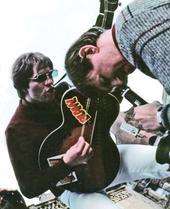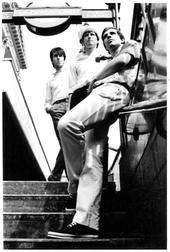The Times (band)
| The Times | |
|---|---|
|
The Times, circa 1983. From L to R, John East, Simon Smith and Ed Ball. Photo by Ray Kent | |
| Background information | |
| Origin | West London |
| Genres | Post-punk, indie |
| Years active | 1980–present |
| Labels | Whaam! Records |
| Associated acts |
Teenage Filmstars 'O' Level Television Personalities The Love Corporation |
| Website | www.myspace.com/thetimeslondon |
| Members | Ed Ball |
| Past members |
John East Dan Treacy Alan McGee Ray Kent Dick Green Paul Damien Paul Heeren Simon Smith Misty Woods |
The Times are a British indie band, the brainchild of Ed Ball, co-founder member of the Television Personalities, Teenage Filmstars and 'O' Level.[1]
Whaam! Records 1981-1982
After releasing a string of 7" singles variously as O'Level ("We Love Malcolm", 1978), The Television Personalities ("Part-Time Punks", 1978), Teenage Filmstars ("There's A Cloud Over Liverpool", 1979, "I Helped Patrick McGoohan Escape", 1980), that culminated with the debut Television Personalities album "And Don't The Kids Just Love It" (1980) on Rough Trade Records, Edward Ball and Daniel Treacy opted for even more artistic control by setting up their own label, WHAAM! Records.[2]
At the same time, recorded as a proposed Teenage Filmstars' debut LP, Ball's 1980 collection of songs was completed as "Go! With The Times", from which the first Times single "Red With Purple Flashes" (1981) was released on Whaam! This was followed by "Pop Goes Art!" (1982), released in individually hand-painted sleeves that executed the band's Pop Art visions.[3]
ArTpOp! Records 1982-1986
On leaving the Television Personalities, and consequently Whaam!, Ball immediately launched the ARTPOP! label with the Times' second single "I Helped Patrick McGoohan Escape!" (September 1982). This was accompanied by humorous tongue in cheek video based on "The Prisoner" T.V. series that starred Patrick McGoohan.[4] Ball's songwriting took a more serious turn with "This Is London" (1983).[5] Songs like "Goodbye Piccadilly", "If Only", and the title track, match the bleakness and despair of Joy Division, the cutting sarcasm of The Jam. After the experimental electronics of "Hello Europe" (1984), Ball fulfilled a long-time ambition to stage Joe Orton's screenplay for the Beatles "Up Against It" at a West London theatre with Tony Conway from Mood Six. This culminated with the Times' fifth album "Up Against It" (1985).[6] Fancying themselves as pirate televisionaries, the Times proceeded by decimating in fiction, within the parameters of songwriting, every symbol of western civilisation with their final ARTPOP! album "Enjoy".[7]
Creation Records 1988-1999
Given the opportunity by Alan McGee to continue recording his skewed visions as The Times, Edward Ball released "Beat Torture" (1988). "E For Edward" (1989) and "Et Dieu Créa La Femme" (1990), recalls his various abilities to humourise fads and trends ("Manchester", "Aurore Boreale"), register sadness and loss ("No Love On Haight Street", "All Your Life") and generally capture the enveloping drug culture that pervaded the label. "Pure" (1991), which contains a 12-minute version of New Order's "Blue Monday" in French ("Lundi Bleu"), sees Ball plunging into his own psyche to create an undisciplined record. Cited by some as the most psychedelic record of the 90s, it reveals the male aspects of group culture ("From Chelsea Green To Brighton Beach") and female distortions and rants ("Another Star In Heaven"), including a performance by Ball's Mum. "Alternative Commercial Crossover" (1993) suggests he is still susceptible to the psychedelics - his combining of James Joyce with Raggamuffin culture ("Finnegan's Break") is a hit-and-miss affair. The album's strength lies in Ball's melodic and sensitive delivery ("All I Want is You to Care", "Sorry I've Written A Melody") that signposts his destiny as a solo artist. "Sad But True" (1997) and "Pirate Playlist 66" (1999) function as secondary tiers to Edward Ball's solo output.
Discography

Studio albums
- Go! With The Times (November 1980 but released in 1985) [Reissued 2006 with extra tracks]
- Pop Goes Art! (January 1982) [Reissued 2008 with extra tracks]
- This Is London (May 1983) [Reissued 2006 with extra tracks]
- Hello Europe (September 1984)
- Up Against It (January 1986)
- Enjoy The Times (December 1986)
- Beat Torture (November 1988)
- E For Edward (October 1989)
- Et Dieu Créa La Femme (August 1990)
- Pure (August 1990)
- The Times At The Astradome (April 1992)
- Alternative Commercial Crossover (April 1993)
- Sad But True (March 1997)
- Pirate Playlist (December 1999)
Compilations
- Pink Ball Brown Ball Ed Ball - July 1991
- Welcome To The Wonderful World of Ed Ball - March 1995
- Here's To Old England! - October 2005
EPs
- I Helped Patrick McGoohan Escape ("I Helped Patrick McGoohan Escape"/"Theme From "Danger Man""/"All Systems Are Go!"/"Big Painting"/"Stranger Than Fiction"/"Up Against It" - November 1983) [Reissued 2006 with extra tracks]
- Blue Period ("Blue Fire"/"Stop In The Name Of Love"/"Tears On A Rainy Sunday"/"I'll See You In My Dreams"/"Boys Brigade" - March 1985)
- Boys About Town EP ("David Jones (Is On His Way)"/"Victim 1960"/"Up Against It"/"Song For Joe Orton" - 12" Artpop! (POP 43DOZ) 1985)
- Times TV ("Times TV"/"Trailer From "Enjoy""/"The Polite Force"/"El Aragua"/"Pick It Up" - 12" Fire Records (BLAZE 16T) 1986)
Singles
- Red With Purple Flashes (Red With Purple Flashes / Biff! Bang! Pow! - 7" Whaam! (WHAAM 002) - May 1981)
- Here Comes The Holidays (Here Comes The Holidays (Voici Les Vacances) / Three Cheers For The Sun - 7" Artpop! (POP 50) - June 1982 - A-side credited to Joni Dee Featuring The Times)
- I Helped Patrick McGoohan Escape (I Helped Patrick McGoohan Escape / Theme from 'Danger Man - 7" Artpop! (POP 49) - September 1982)
- Boys Brigade (Boys Brigade / Power Is Forever - 7" Artpop! (POP 46) - 1984)
- Blue Fire (Blue Fire / Where The Blue Begins - 7" Artpop! (POP 45) 1984)
- London Boys (London Boys / (Where To Go) When The Sun Goes Down - 7" Unicorn (PHZ 1) 1986)
- Times TV (Times TV / Trailer From "Enjoy" - 7" Fire Records (BLAZE 16S) 1986)
- Manchester (Manchester / Love And Truth - 7" Creation Records (CRE071) Jan 1990 - Manchester / DaDa Won't Buy Me A Bauhaus / Manchester (extended) - 12" Creation Records (CRE071T) Jan 1990 -
- Manchester (Manchester / Manchester (extended) / Ulysses / Shoom! - CD Creation Records (CRESCD71) Jan 1990
- The Mods Are Back! (The Times: 'Extase' / Biff Bang Pow: 'Sleep' - Split 7" Caff Corporation (Caff 13) 1990)
- Lundi Bleu (Lundi Bleu / Lundi Bleu (Instrumental) - 7" Creation Records (CRE114) 1992)
- Lundi Bleu (Lundi Bleu (Praise The Lord Mix) / Lundi Bleu (The Grid's World Communication Mix) / Lundi Bleu ('Smiling' Remix) - 12" Creation Records (CRE114T) 1992)
- Lundi Bleu (Lundi Bleu (Radio Edit) (4:01) / Lundi Bleu (Praise The Lord Mix) / Lundi Bleu (The Grid's World Communication Mix) / Lundi Bleu ('Smiling' Remix) / Lundi Bleu (Brazilian Vocal Edit) / Lundi Bleu (Japanese Vocal Edit) / Lundi Bleu (German Vocal Edit) / Lundi Bleu (Spanish Vocal Edit) - CD Creation Records (CRESCD114) 1992)
- Finnegan's Break (Finnegan's Break / Heartbroken Lost In Blue - 7" Creation Records (CRE158) 1993)
- Finnegan's Break (Finnegan's Break [Edit] / Heartbroken Lost In Blue / Soul Tight / Come Alive - 12" Creation Records (CRE158T) 1993)
- Baby Girl (Baby Girl / The Colour Of My Love - 7" Creation Records (CRE162) 1993)
- Baby Girl (Baby Girl / The Colour Of My Love / Mash It Up / Primrose 0822 - CD Creation Records (CRESCD162) 1993)
Compilation Appearances
- A Splash Of Colour (WEA Records 1981) "I Helped Patrick McGoohan Escape"
- The Countdown Compilation (5-4-3-2-1 Go!) (Countdown 1985) "Whatever Happened To Thames Beat"
See also
References
- ↑ http://www.allmusic.com/artist/edward-ball-mn0001009756/biography
- ↑ "Ed Ball: Interview with the modernist musical alchemist.". Creation Records. August 2005. Archived from the original on 2006-11-04. Retrieved 2007-03-29.
- ↑ http://www.allmusic.com/album/pop-goes-art%21-mw0000796540
- ↑ "The Times - I Helped Patrick McGoohan Escape".
- ↑ http://www.allmusic.com/album/this-is-london-mw0000465993
- ↑ http://www.allmusic.com/album/enjoy-up-against-it-mw0000796539
- ↑ Ball, Edward (December 1989). "They Could Have Been Bigger Than Elvis A Ten Year History Of The Times, The TV Personalities, The Teenage Filmstars and O Level". Spiral Scratch No. 11. Archived from the original on 2006-11-20. Retrieved 2007-03-29.
External links
- For more on The Times and Edward Ball
- The Times' Myspace site
- For more about The Times' Up Against It
- Myspace site dedicated to "E For Edward"

